Disclosure: We may earn money or products from the companies mentioned in this post.
Setting up your first indoor rabbit hutch can be daunting, but we’re going to walk you through the whole process to make setting up your rabbit’s home simple and to help you avoid any costly mistakes. This article is a little long, but it’s laid out to easily walk you through everything you need to consider when setting up your first indoor rabbit cage.
The first bit of advice, take your time reading this article so you can get your new rabbit hutch set up just right…for the sake of your bunny, your family, and your home.
Indoor Rabbit hutches and cages are important for a rabbit’s welfare because it’s not just a house for your rabbit, it’s their safe space as well as a place where they can hide and rest when things get a little bit rowdy at home. You want to set up the best possible home for your bunny.
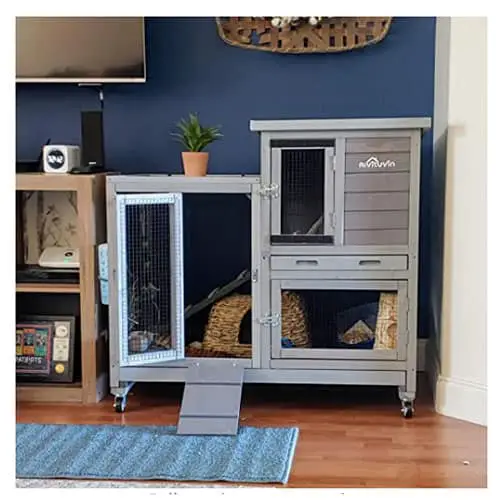
Why Choose An Indoor Rabbit Hutch
There are several decisions you’ll need to make and then many indoor rabbit home set-ups to choose from as a new rabbit owner.
In this article, we will be focusing on setting up indoor hutches/cages, however, before we go into the details of the setup, I’d first like to briefly discuss the advantages of housing your rabbit in an indoor rabbit hutch as opposed to other options.
Indoor Rabbit Hutches vs Outdoor hutches
There are three primary advantages to keeping your rabbit in an indoor hutch vs keeping them outdoors.
- Safety – There are more predators outside, and if they find your rabbit hutch they will try to get into it.
- Temperature – Rabbits handle the cold pretty well, but the heat is tough on them and can even be fatal.
- Bonding – If your rabbit is lives outside, you will not spend as much time with them.
For these reasons, most people choose to keep their pet rabbits inside their house.
Indoor Rabbit Hutches Vs Puppy Pens
Puppy pens are open-topped fences that are used to corral small dogs. Sometimes they are called X-Pens. If you’re still not sure what I’m talking about, here’s a link to a rabbit XPen Amazon for you to check out.
There are three primary disadvantages to Rabbit Pens vs Rabbit Cages.
- Space – Rabbit pens take up a lot more space than rabbit hutches.
- Safety – Often the space between the wires on a puppy pen is large enough that a rabbit can get its head stuck between the wires. Some of the pens are too short to keep a rabbit from jumping out. In addition, these pens offer very little protection from preditors such as dogs.
- Appearance – The x-pens used as rabbit homes can look really messy. If I ever had one, it would have to have its own room and not be part of the family living area.
Meanwhile, there are beautiful rabbit hutches that can double as room decor while serving as a safe and secure rabbit home.
Indoor Rabbit Hutch vs Free-Roaming Bunnies
You will hear of people strongly advocating for free-roaming or free-ranging your house bunny which means that the pet bunny doesn’t have a hutch, cage, or pen of any kind. Instead, free-roaming rabbits have full access to the entire house or perhaps live in a rabbit room.
I believe that free-roaming your rabbit can give them the best possible life, but I do not think it’s an ideal living arrangement for a new rabbit or a new rabbit owner.
New rabbits are often skittish and their instinct is to hide. If you have to search your whole house for a lost rabbit, you might be in for a long day. Likewise, rabbits are chewers, and trying to rabbit-proof your whole house seems like an impossible task.
Just as importantly, sometimes when you have company visiting, you’re going to want to have a space where your rabbit can be contained for their own safety.
For these reasons, I strongly suggest that when you bring a new rabbit home they first move into a rabbit hutch. After they get used to their hutch, then you can introduce them to free-ranging in an area of your home that is rabbit safe.
We believe the ideal living arrangement for an indoor bunny is to have a nice large hutch where they spend time when unsupervised. Then when you’re home and spending time with your bunny, the hutch opens to allow the rabbit to come out into the larger room and free-range.
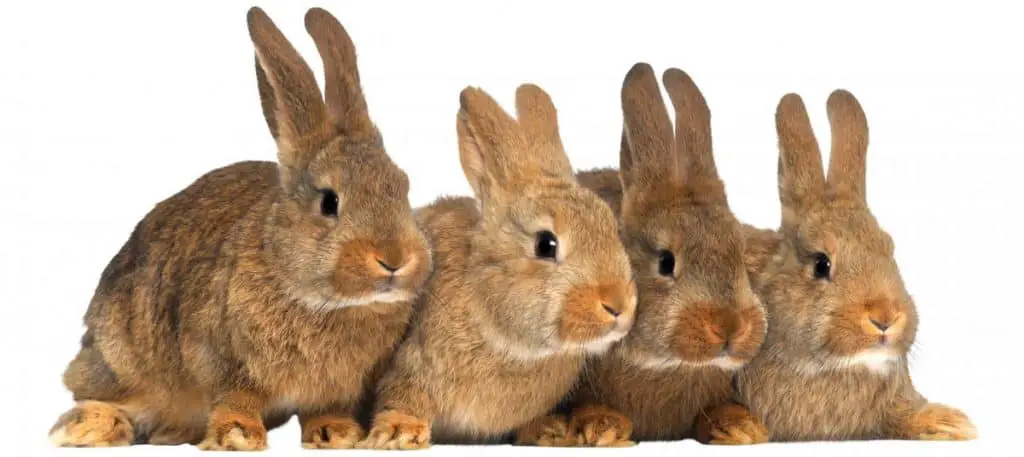
Rabbit Hutch Size
When deciding how big of rabbit cage or hutch that you need, there are two ways to look at it:
- Minimum Size
- Ideal Size
First, Let’s look at the minimum rabbit cage size.
Minimum Rabbit Cage Size
The United States passed The Animal Welfare Act in 1966 as the first and only federal law that regulates the treatment of animals in research, exhibition, transport, and by dealers. Through the years, the law has been updated several times with the most recent being in 2015.
While the regulations in this law don’t regulate pet rabbits, they can still serve as a guideline for pet owners for the minimum acceptable treatment of pet rabbits.
The Michigan State University (MSU) summarized regulations related to the minimum rabbit cage sizes and we’ll share that table below. You can view the original MSU table here.
Table Of Minimum Cage Size For Rabbits
| Rabbit Weight | Minimum Square Ft |
| Less than 4.4 lbs (2 kg) | 1.5 Sq Ft |
| 4.4 to 8.8 lbs (2 to 4 kg) | 3 Sq Ft |
| 8.8 to 11.9 lbs (4 to 5.4 kg) | 4 Sq Ft |
| Over 11.9 lbs (5.4 kg) | 5 Sq Ft |
It’s worth noting that the regulated minimum interior height of a rabbit cage is 14 inches for all sizes of rabbits.
And now that we know what the regulations say, let me be clear that I don’t think this is a big enough cage for a rabbit. So now let’s look into the ideal size for a rabbit hutch.
Ideal Size For A Rabbit Hutch
Ideally, a rabbit hutch or cage should be at least six times larger than the rabbit(s) that live in that hutch. This means that an average-sized rabbit should have at least 6 sq ft of living space and two average-sized rabbits should have a cage with at least 12 sq ft of space.
While it’s generally accepted that pet rabbits should have a cage that is at least four times larger than the rabbit, that is just the minimum size, not the ideal size. Rabbits need space to run, play, sleep, eat, drink, and go to the bathroom within their rabbit hutch. Four square feet is just 2 ft by 2 ft. That’s not big enough to live in!
You can approximate how big a rabbit hutch/cage you should get based on the size of your rabbit. To make things easier for you I did some sample computations for you on the table below. If you have 2 rabbits sharing one hutch, measure the size of the hutch based on the bigger rabbit.
| Size Of Rabbit | Sq. Feet For 1 Rabbit | Sq. Feet For 2 Rabbits |
| Less than 4.4 lbs (2 kg) | 4.5 Sq Ft | 9 Sq Ft |
| 4.4 to 8.8 lbs (2 to 4 kg) | 6 Sq Ft | 12 Sq Ft |
| 8.8 to 11.9 lbs (4 to 5.4 kg) | 7.5 Sq Ft | 15 Sq Ft |
| Over 11.9 lbs (5.4 kg) | 10 Sq Ft | 20 Sq Ft |
A tiny rabbit needs a cage that’s about 24” x 30”, a small rabbit cage that’s 24”x36”, a larger rabbit needs a cage size of 30” x 36”, and a giant rabbit needs a cage size of 36” x 42”. If your hutch has two levels, then the square feet of both levels are added together to get the total size of the rabbit hutch.
If your rabbit is going to be able to spend at least two hours outside of their rabbit cage every day, you can go with a slightly smaller cage. However, if you suspect that there will be days when your rabbit is going to be left alone, then I encourage you to go with a bigger cage. Honestly, I suspect that your rabbit is going to be left alone all day on a pretty regular basis, that’s just life.
Here in a bit, we’re going to recommend our favorite indoor rabbit hutches, and we’ll give you the square feet of each hutch and let you know what size and how many rabbits the hutch is appropriate for.
But first, let’s talk about how to choose the best rabbit hutch for your rabbit and your home.
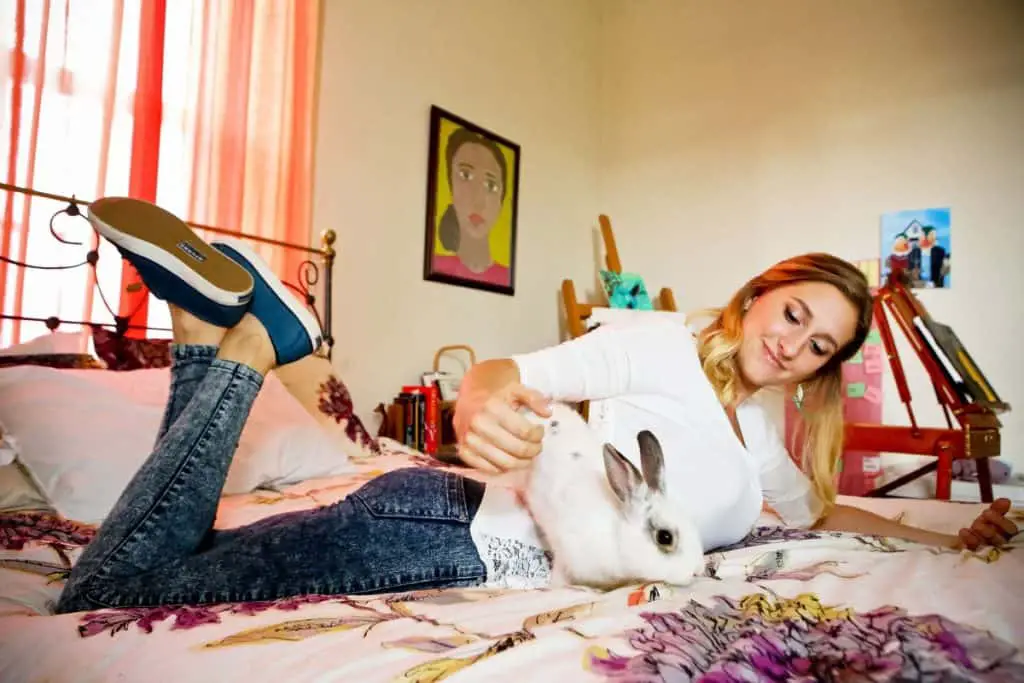
Average Rabbit Hutch Cost
The average cost of the 33 popular rabbit hutches on Amazon is $190.54 and they ranged in price from $93.99 to $329.98. However, there are some custom rabbit cages that cost as much as $1,850.00!
Choosing The Right Indoor Rabbit Hutch
There are excellent indoor rabbit hutches out there in the market and there are also those that are not so good. With so many choices it can be confusing but let me help you make the choice easier.
These are thing things that you should consider when choosing the best rabbit hutch for you and your bunny.
Proper Size
You have to choose a rabbit hutch that is appropriately sized for your rabbit(s) as we discussed above.
Almost as importantly, you need to choose an indoor rabbit cage that fits into the space you have for a hutch.
Keep in mind that when choosing the minimum size of a rabbit’s enclosure it talks about the floor space, but that floor space doesn’t necessarily have to be on one level. If you get a bi-level rabbit cage you can have more space for your rabbit, but still have a smaller footprint for the rabbit cage.
Tall Enough
Your rabbit needs some vertical space too. While bunnies spend most of their time on the floor, they also like to periscope, which is a behavior where they stand up on their back legs.
Now I don’t know this for sure, but I got to think that periscoping is good for their little backs, so make sure that your bunny has enough height in their cage to stand tall, without their ears hitting the top of the cage when they choose to.
Untreated Wood
If you are thinking of getting a hutch that is made of wood, it is always best to choose untreated wood. Treated wood when chewed by a rabbit – and they can be big chewers- can be toxic.
Untreated pine is good, non-toxic wood and is an excellent material for a rabbit hutch. Just watch out for treated pine, which tends to have a green color to the wood. That stuff is designed to survive the weather, but your bunny isn’t designed to survive chewing on it all the time.
Solid Construction
You don’t want an indoor rabbit hutch that feels flimsy.
Pay special attention to the legs and how they attach to the hutch. We prefer legs that don’t attach to the bottom but instead run all the way to the top of the hutch. It just makes for a more secure leg that is less likely to buckle if someone heavily leans on your rabbit home.
Next take a look at the hinges for any opening windows, doors, or ramps. Those hinges, or more specifically, the screws that attached them are often the first thing to fail on cheap indoor rabbit hutches.
A Bed Area
Your new pet bunny’s wild ancestors are still sleeping in holes in the ground. As prey animals, a hole in the ground is the safest place for a wild rabbit to live.
Given a choice, your cute bunny would also choose to live in a hole in the ground, but as we both know that’s not possible for an indoor bunny.
Still, we can give them an approximation of that hole-in-the-ground by making sure that the indoor rabbit cage that you choose has a bedding area that gives them some darkness and privacy.
Well Attached Wire Panels
I know this is an indoor rabbit hutch, but rabbits are prey animals and in almost every case where I’ve seen a predator (even a pet dog or cat is a predator) get to a rabbit it’s been by popping out a welded wire panel or pushing up the bottom panel.
These panels need to be solidly attached, not just laid in the bottom or set into in shallow channels.
Secure Closures
Rabbits are pretty smart animals and some of them become quite the escape artist. Make sure that the latches on all openings are either inaccessible from the inside or actual latch in some way and don’t just flop down.
Pull-Out Under Tray
A pull-out under tray makes cleaning so much easier. I wouldn’t own a rabbit hutch without a pull-out tray that’s pretty deep to make cleanup easier.
Opening And Closing Windows
While I know this is going to be an indoor rabbit home, I think it still needs windows that open and closes so you can give your bunny a little more fresh air or close her up for a little more warmth if her corner of the house gets cool in the winter.
Solid And Secure Floor
Your rabbit and all his gear is going to weigh more than you think. The weight of a rabbit, litter box, food, water, and toys starts to add up. Just make sure that your cage floor can hold more weight than you think it will ever be asked to hold.
Some Non-Wire Flooring
Some rabbit lovers are adamant that there be no wire flooring in a rabbit hutch. They feel this way because standing on wire all day can cause your rabbit pain and even sores on their paws. I know that they are right because I’ve seen it happen over the years.
However, the key part of the above statement is “all day”. If a rabbit can get off of the wire when they want to, I’ve never seen feet problems caused by the wire.
And the wire bottom lets waste fall through to the undertray, so I really like it. We just make sure that our rabbits can get off the wire when they want to.
Some hutches have some areas of the floor that are solid wood, but if they don’t you can create non-wire areas by cutting a board to lay over the wire or just by tossing a rug or towel over one portion of the flooring.
Large Doors Or Gates For Cleaning
Rabbits are very clean animals, but their litter box and cage are going to need to be cleaned regularly to keep them from starting to smell. Big doors or gates that swing entirely out of the way make this job much easier. I like to see doors on multiple sides of a rabbit hutch so I’m not crawling halfway inside to reach the entire cage.
A Ramp To Free-Roam
While we suggested above that you don’t start by free-roaming your rabbit, in time you’ll likely want your rabbit to be able to roam around the room where their rabbit hutch is located. There’s nothing more enjoyable than sitting on the floor and having your bunny binkying around your legs.
So when choosing a rabbit hutch, plan for that eventuality and look for one that has an easy way for your rabbit to get in and out of her hutch. If there is a ramp that opens to the floor, you can easily open it so your bunny can come and go as they like when you are there to supervise and can be closed when you need your bunny to stay in their rabbit home.
Attractive Appearance
This seems a little vain, but I think it’s worth considering. You are buying an indoor rabbit hutch. You are buying a large indoor rabbit hutch or cage. It’s going to be part of your home. It might be the biggest piece of furniture in the room.
Get one that looks good and will be a wonderful conversation piece, not an eyesore that embarrasses you when friends come over.
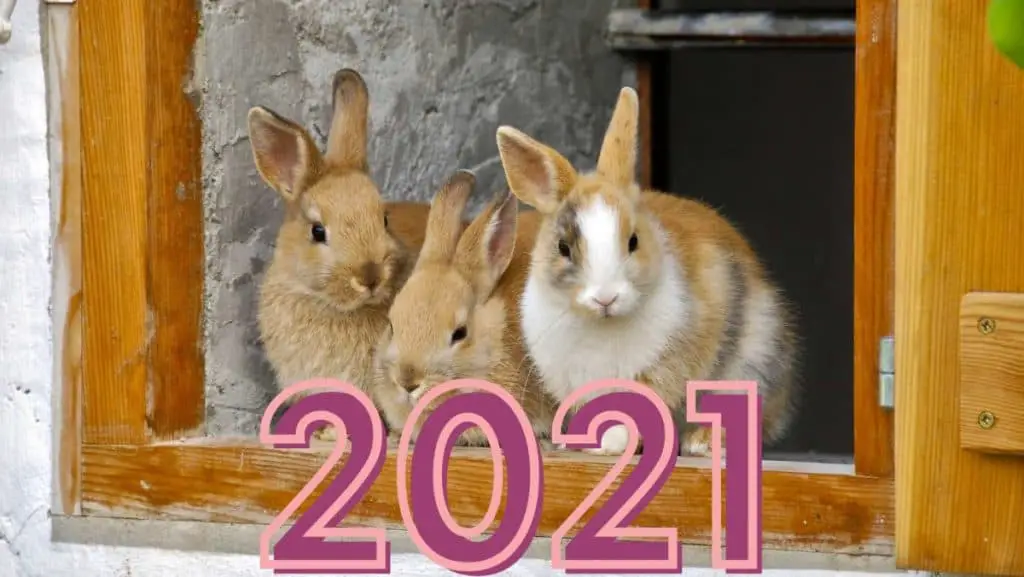
Best Indoor Rabbit Hutches 2021
To make your search for the best indoor rabbit hutch easier, our team has chosen our favorites and we’ve broken them down by size.
We’ve even told you what size of rabbit each rabbit hutch is suitable for.
However, we encourage you to get the largest hutch that fits your space and budget. Bigger is better for your bunny.
Doesn’t get any easier, right?
Best Small Rabbit Hutch

Roughly 7.4 Square Feet of Space – One Medium Rabbit
- Full under tray
- Ramp to floor at end of hutch
- Second level platform
- Inclosed sleeping area
- Fully opening top
- Wheels for easy moving
- Small enough for small spaces
Best Medium Rabbit Hutch

Roughly 9.4 Square Feet of Space – One Large Rabbit or Two Small Rabbits
- Two levels for more space
- Trays under all areas, including top level
- Ramp to floor
- Attractrive piece of furnature
- Wheels for easy moving
- Lots of doors for easy cleaning
Best Large Rabbit Hutch

Roughly 12.5 Square Feet of Space – One Giant Rabbit or Two Medium Rabbits
- Large open area on lower level
- Nice enclosed area up top
- Big pullout trays for easy cleaning
Largest Rabbit Hutch

Roughly 13.4 Square Feet of Space – One Giant Rabbit or Two Medium Rabbits
I want to be clear that this is a really good hutch too, and we were a little misleading when we called it the largest rabbit hutch when in reality it’s the largest high-quality rabbit hutch. There are some larger rabbit cages, but they are poorly built.
- Really large
- Slide out trays
- Wheels
- Lots of doors for easy cleaning
Where To Put An Indoor Rabbit Hutch?
Deciding where you are going to put your indoor bunny hutch is a very important decision. To that end, let me give you a list of things to consider before you decide where to put your rabbit hutch.
Things To Consider When Placing An Indoor Rabbit Hutch
1. Consider Traffic
You want your rabbit hutch to be in an area where people are going to be. You do not isolate your rabbit.
You should put them in a space that encounters people traffic regularly, and ideally for longer periods of time. Rabbits who are isolated tend to be stressed out and added stress will reduce a rabbit’s lifespan.
I know this is a delicate balancing act because although your rabbits need to feel like they are part of the family, they should however not be placed in a space that is loud and rowdy. For example, if the kids have a playroom, I don’t recommend placing your rabbit hutch there because children tend to be loud and this will scare your rabbit.
2. Consider People Activities
You’re looking for a place to put your rabbit hutch where people are around. TV rooms are great, as are reading areas. When you put your rabbit hutch in an area of your home where the family already hangs out, you’re naturally going to spend more time with your new bunny.
3. Consider Free-Roaming Time
Ideally, your bunny is going to get time out of her hutch daily so think about how that free-roaming time is going to work.
For example, I like indoor rabbit hutches to be in an area that can be shut off from the rest of the house. This means I can sit on the floor with my bunny and really let the bunny free-range throughout the room and not have to keep getting up to chase them down the hallway.
Once they get to know their roaming area, you’ll start to see them relax and play, and nothing is more enjoyable than watching a bunny binky.
4. Consider Temperature
Put your rabbit hutch in an area that’s not too cool and too hot. In most homes, this isn’t an issue.
Rabbits handle cold just fine, and if your water pipes aren’t frozen solid, your bunny is going to be just fine.
And if you’re comfortable with the heat in your home, your rabbit will be fine too.
However, keep in mind heat sources, and don’t put your rabbit directly beside a major heat source. For example, don’t put your rabbit hutch next to the wood-burning stove or directly beside the room’s space heating.
5. Consider Flooring
If you started with a quality rabbit hutch, you’re going to have lots fewer messes hit your floor. However, you are going to have some messes fall outside of the rabbit cage.
It might be a flipped litter box or a spilled water bowl, but something is going to hit the floor.
For this reason, I don’t put rabbit hutches over nice carpet, and if I do I put some kind of floor liner under the hutch.
If you can’t find a location where the flooring meets your needs, below we’ll go into greater detail about what you can put under a rabbit hutch.
6. Consider Appearance
Remember that you’re going to have this rabbit hutch as part of your home for the lifespan of your rabbit, so you want to choose a location where the rabbit hutch is going to look nice and might even be a centerpiece and conversation starter.
Things To Avoid When Choosing An Indoor Rabbit Hutch Location
1. Dusty Areas
If your rabbit is constantly breathing dust, it’s not going to be good for their longterm health.
2. Avoid Sunny Windows
While it’s nice to give your bunny a view, you should avoid locating your rabbit hutch where it will be hit directly by sunlight. This can overheat your rabbit on sunny days.
3. Avoid Larger Pet Spaces
Never forget that rabbits are prey animals, and no matter how sweet your dogs are they are predators…even rabbit predators.
While rabbits and dogs can learn to become fast friends, it’s going to take time for your dog to learn that the bunny is not something to chase and for your bunny to learn that the dog isn’t a threat.
Make sure that your hutch is in a location where you can keep your larger pets away from unless you are in the room to supervise and facilitate the bonding of your pets.
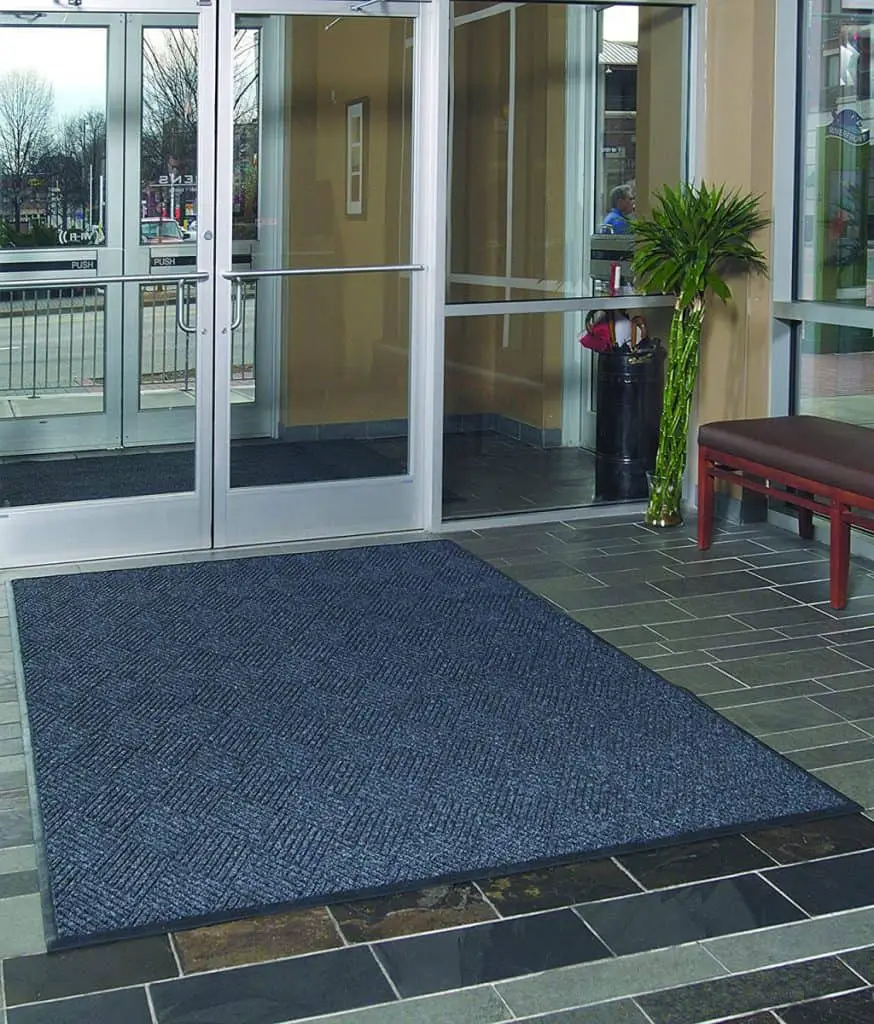
What To Put On The Floor Under An Indoor Rabbit Hutch?
Rabbits are very clean animals, but they are sometimes messy. While a high-quality rabbit hutch (like the hutches we recommend above) will have pull-out trays to protect the floor, sometimes messes will hit the floor.
The most common kinds of messes are tipped over litterboxes and food or water bowls, ideally, we’d like to keep all of these messes off your nice carpet or hardwood floors.
It is a good practice to put a liner under your indoor rabbit hutch to protect your floor from messes. We recommend outdoor rugs, washable puppy pads, or large splat mats be placed under your rabbit hutch and cleaned at least once a month.
Our first choice is the outdoor rug because they just look nicer and usually has rubber backings and edges to contain a decent amount of spilled water.
For your convenience, we’ve included Amazon affiliate links to each type of under-rabbit cage floor liners.
- Large Outdoor Rug
- Large Washable Puppy Pad
- Large Splat Mat
- Secret Option #4 – Custom Bunny Flooring From Etsy…it’s not inexpensive.
Lining A Rabbit Hutch Tray – The Under Tray
Lining your rabbit hutch’s pullout undertray makes regular cleanup much easier. We prefer to line our rabbit’s tray in two layers. The first layer is to keep messes from sticking to the tray and that layer is topped with absorbent material.
We recommend that the bottom layer in your rabbit tray lining be made up of either puppy pads, cardboard, or newspapers. Each of these will provide the final layer of absorbancy and will limit how much sticks to your rabbit hutch’s undertray.
Puppy pads are effective and easy, but the cost of them will add up over time. { Click here to check the price on Amazon. >>> }
Cardboard can be cheap, but you’re probably going to be raiding local cardboard recycling bins a couple of times a month.
Newspapers used to be easy to get, but it’s getting harder all of the time. If you still take a print newspaper, you can certainly use yesterday’s news to line your rabbit cage tray, just be sure to use multiple layers so that the bottom layer remains dry and doesn’t stick.
For the second layer, I use a layer of rabbit-friendly litter. We surveyed rabbit owners to find out what most people use as litter, and the two most popular options are paper litter and pine pellets. P.S. Here’s a link to our research about rabbit littler boxes.
Paper-based litter is usually very absorbent and they come with odor control to keep your rabbit’s cage from stinking up. The most popular brand mentioned by my rabbit friends is CareFresh. { Click here to see CareFresh on Amazon >>> }
Pine pellets are absorbent, but not as much so as paper litter. However, it can be relatively inexpensive, especially if you buy it locally at a nearby farm supply store (look for Tractor Supply or Orshlins).
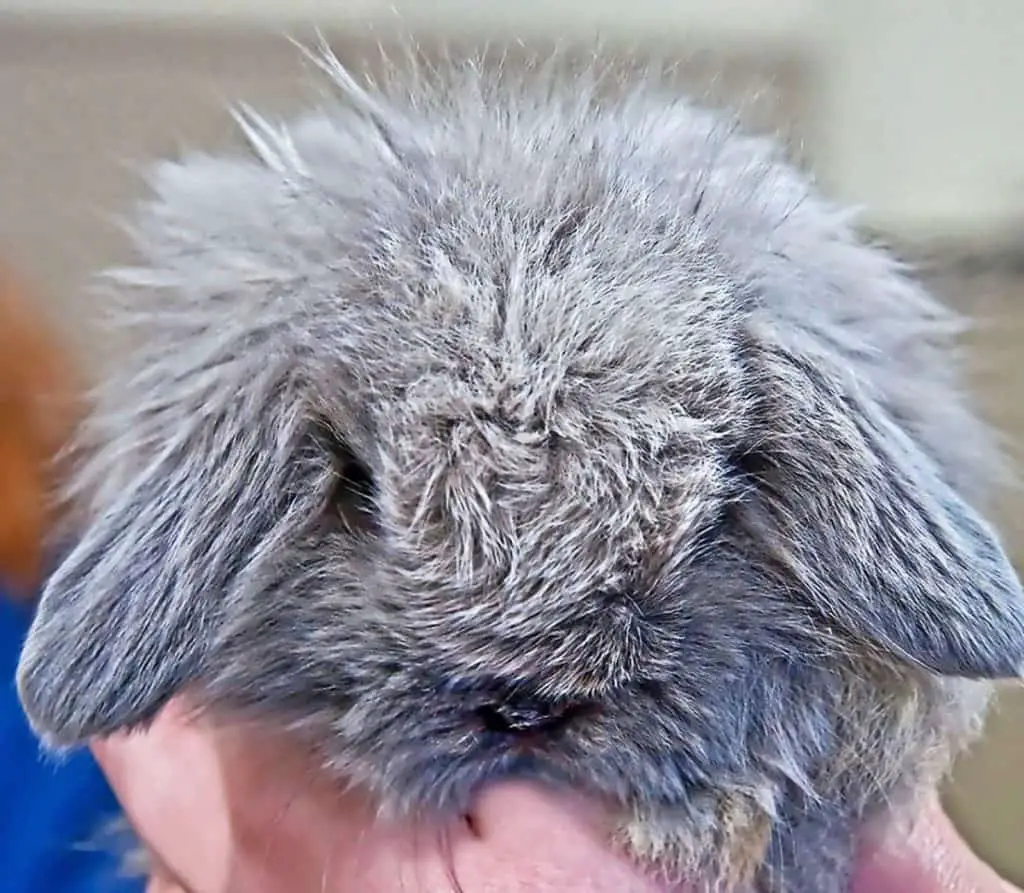
What To Put In A Rabbit Hutch
There is some essential rabbit gear that needs to be inside your rabbit’s indoor cage. This is one of the reasons why your rabbit hutches/cages should be spacious enough to hold your rabbit and still not be cramped with their necessities.
We’ve listed all of thing things that you need to put in your indoor rabbit hutch below.
1. Water Bowl or Water Bottle
You must keep your rabbits well hydrated. Water aids in your rabbit’s digestion and it keeps their digestive tract well lubricated, so in case they eat something that they should not have (like rabbits eating plastic…it happens) it will pass more easily through their system.
A pet owner has two options for providing water to their pet bunny: a water bowl or a water bottle. But which is better?.
Honestly, both water bowls and water bottles are fine choices, but not the best choice.
Lapping up water is more natural for rabbits so a water bowl will be more comfortable for them, however, water bowls can also be upended when rabbits play.
Water bottles, however, can’t be upended but your bunny will take more time getting used to drinking from a water bottle and they can get clogged. Water bottles have an additional advantage of usually being hung outside of your bunny’s cage (with the drinking tip poking to the inside of the cage) which preserves valuable floor space.
The best rabbit waterer is to have two water sources of different types so you will always be sure that your rabbits will never run out of drinking water. We recommend a water bowl and a water bottle inside of your rabbit hutch.
Place your rabbit water near their hay baskets and away from their bedding. You want to avoid getting water spilled on your rabbit’s beddings because it will increase the chances of your rabbit’s fur getting wet. A damp rabbit is susceptible to hypothermia plus, moist fur is a breeding ground for bacteria and parasites that
Recommended Rabbit Waterers
- Rabbit Water Bowl – Attaches to the side of the rabbit hutch so it can’t be knocked over.
- Rabbit Water Bottle – Attaches and detaches easily for refilling, yet has a solid connection to the cage.
- Rabbit Outside Cage Water Bowl – A water bowl with an outside water reserve to save cage space.
2. Hay Basket
80% of a healthy rabbit diet should come from hay. In fact, rabbits eat so much hay that they can eat a pile of hay the size of their body in just a single day! P.S. If your rabbit doesn’t eat that much hay, you should read this article about getting your rabbit to eat more hay.
Quality hay should always be in your hutch. You can simply line the floors of your cage with hay because it will be comfortable for your rabbit’s feet, and you can use hay as your rabbit’s beddings as this will keep your rabbits warm.
However, a hay basket is a good way to provide hay for your rabbit and to keep that hay unsoiled.
I suggest that you keep it hanging near or above the space you designated as a litter box or bathroom area. Not only do rabbits spend a lot of time going to the bathroom and they also have a habit of eating while going, so it’s always a good idea to keep your hay baskets near.
Recommended Rabbit Hay Baskets
- Rabbit Hay Bag – Inexpensive, rugged, and attaches solidly to the side wall to save floor space.
- Combined Rabbit Hay Feeder And Litter Box – If this fits in your budget, it provides a lot of essentials in one spot and it will stop your rabbit from making messes by flipping their litter box, water bowl, or feed bowl. This is large, and might be a better option for when your bunny is free-ranging.
3. Litter Box
You can choose to not have a litter box in your rabbit’s hutch and instead just let them use the undertray as a litterbox, but I don’t recommend this.
By not having a litter box, you are teaching your rabbit that they can do their business anywhere, and that bunny behavior is going to make free-ranging time really unpleasant.
I recommend that every indoor rabbit hutch have a smaller litter box in one corner. P.S. Here’s a link to the ultimate guide to rabbit litter boxes.
Recommended Rabbit Litter Box For Inside A Rabbit Hutch
- Corner Litter Box – Easy to clean. Make sure to pick one that fits your rabbit’s size. If you’re not sure what size you need, check out this article about rabbit’s tipping their litter box.
- Combined Rabbit Liter Box And Feed Station – If this fits in your budget, it provides a lot of essentials in one spot and it will stop your rabbit from making messes by flipping their litter box, water bowl, or feed bowl. This is large, and might be a better option for when your bunny is free-ranging.
4. Bed Area / Bedding
In the wild, rabbits would be living in holes in the ground. In their cozy indoor rabbit cage, they still need a bed that is a rough appropriation of that hole in the ground. That usually comes in the form of a bed box that has a small opening and is mostly enclosed to give your bunny the feeling of safety.
If the rabbit hutch you purchased doesn’t have a bed box, you need to put one in your bunny’s cage.
Look for a bed box that has an opening just large enough for your rabbit to enter and one that has enough space for your rabbit to turn around while inside and easily lay on their side in one direction.
We prefer grass beds with a flat top. Being a grass, the beds double as a chew toy and the flat top gives your bunny a perch from which to survey her domain. For most bunnies, a grass bed will only need to be replaced once or twice a year. { Click here to see the one we like most on Amazon. >>> }
If you haven’t yet purchased a rabbit hutch, I hope you’ll look at our recommended indoor rabbit hutches before you decide which hutch to buy. Each of our recommended rabbit hutches has an enclosed bed area.
Do Rabbit’s Need Bedding?
Rabbits do need some form of bedding because they need a comfortable and warm place to sleep. Most people use hay as bedding because it doubles as food for their bunny. Other people like to use old towels or something similar as bedding because it can be washed.
You should be feeding your rabbit timothy hay as part of their healthy rabbit diet, and you could use that same hay as bedding. This is what most rabbit owners do, and it is what I recommend that you do.
Alternatively, you could less expensive wheat straw for bedding. Your rabbit will also eat this straw, but it has little nutritional value and they won’t eat a lot of it as long as they have access to high-quality timothy hay as well.
Recommended Rabbit Bed If Your Rabbit Hutch Doesn’t Have One
- Grass Bed – Made of natural material because your rabbit will chew on this. You’ll probably need to replace it once a year.
5. Wire Floor Covering
Standing on wire flooring can hurt your rabbit’s feet over time. But if they have the option to move off of the wire when it begins to dig into their toes, they’ll be just fine.
If your rabbit hutch has 100% wire flooring, you should cover about 50% of the wire flooring with something to allow your rabbit to get off the wire when they want to. Options include Old Towels, Old Blankets, Rugs, or even a board
Here is a link to an article about what to put on the bottom of a rabbit hutch to give you more ideas about what you could put over the wire bottom of your rabbit’s cage.
6. Rabbit Chew Toys
Rabbits literally must chew on things…they don’t have any choice.
You see, a rabbit’s teeth grow continuously. From the day a rabbit is born until the day they die, their teeth are growing and the only way they can keep their teeth from getting so long that they can’t eat is to chew on things to grind their teeth down.
Now if your rabbit is eating an ideal rabbit diet, the hay that makes up the majority of their food will keep their teeth ground down. However, some rabbits don’t eat enough hay, and these bunnies need chew toys to keep their teeth at a healthy length.
When you’re looking for rabbit chew toys to put in your rabbit’s cage, we suggest that you choose natural chew toys. We’re going to give you some links to our favorites below.
You have to buy rabbit chew toys, you can find your own in your yard as long as you 100% know that what you bring your bunny hasn’t been sprayed with chemicals. Look for sticks and pinecones as great free rabbit chew toys.
P.S. We like to include chew toys that can hang from the top of the cage. They save your bunny some floor space and they give her exercise as she stands up to reach the chew toy.
Recommended Rabbit Chew Toys
- Woven Mats – We’re a big fan of these. They double as a chew toy and a place for your bun to get off of the wire bottom of their rabbit cage.
- Hanging Chew Toy – These are simple chew toys made of grass balls and pieces of wood. You can get them on Amazon, or you can make your own.
How to maintain your Rabbit Hutch – Best Cleaning Tips and Tricks
Now that you know how to set up your rabbit hutch. I feel that I should give you a quick primer on how to maintain it so it remains a healthy and safe home for your bunny and so your hutch lasts as long as possible.
Most people clean their rabbit hutch once a week. Listed below are some of the best tips and tricks to keep your hutch in tip-top shape.
- Clean your hutch at least once a week but the litter box should be cleaned at least everyother day and more often if you have more rabbits using it.
- If you are not using a little box and are dependent on the under tray, clean the under tray every other day and more often if more bunnies live inside the hutch. You can use the mixture of apple cider vinegar, baking soda and water to clean your undertray. Let the solution soak for 15 minutes, this is effective in removing urine stains from the undertray.
- You can use the solution of 1 part bleach to 10 parts water when cleaning your rabbit hutch. This will disinfect the hutch as well as clean it thoroughly.
- Allow your rabbit hutch to dry thoroughly before returning your bunny to it. Putting a fan blowing into your rabbit hutch will dry it out a lot faster.
- Try to return everything that says in the hutch to about the same place. Avoid rearranging things as much as possible. Rabbits are animals that like routine and changing the layout of their hutches can easily stress them out or even make them stop using their litter box.
- If you have some kind of water leak or constant water spills, you need to address that problem. Constantly moisture will cause the wood parts of your hutch to rot and metal parts to rust.
- Each time your clean your hutch, check all the panels to make sure they are still tightly secured. Also check for rusted or broken wires which could stab your bunny (our yourself).
- If your rabbit is having trouble hitting their litter box, watch the area around the box for rust.
- Double and tripple check an latches before you walkaway after putting your bunny back in their hutch.
We do hope that this article has answered all of your questions about choosing an indoor rabbit hutch, setting it up, and maintaining it. If we missed something, please let us know in the comments below or jump over to our pet rabbit group on Facebook and ask your question there.
